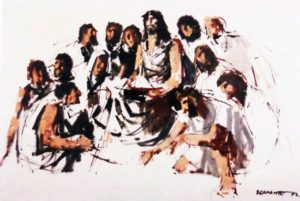
John, testifying of the incarnation, goes to lengths in his first letter to emphasise historical facts – “That which was from the beginning, which we have heard, which we have seen with our eyes, which we have looked at and our hands have touched – this we proclaim concerning the Word of Life.” (1:1-4)
The faith that overcomes the world is a very specific belief, “that Jesus is the Son of God.” (5:5) If Jesus is the only way in which we can come into fellowship with God then we must have the right Jesus. Cerinthius, and other false teachers deny the incarnation, insisting that Jesus was the son of Joseph and Mary, that Christ joined Jesus at his baptism to equip him for ministry and left him before the crucifixion. This meant an ordinary man died on the cross. John refutes that and shows us the true nature of Jesus.
The One Who Came
The first fact John affirms in our passage is that Jesus Christ is “the one who came” (5:6). That Jesus, a real man, who lived in real time and space (1:1-4) the incarnation of the eternal Son of God. The angels declared that ‘Christ the Lord’ was born a babe in Bethlehem. The star directed wise men to that same place where ‘the king of the Jews’ had been born to Mary.
The Palm Sunday crowds greeted Jesus as, “he who comes in the name of the Lord!” (Mt.21:9) and John the Baptist referred to Jesus as, “he who comes after me has surpassed me because he was before me.” (Jn.1:15) When the Baptist sent to see if Jesus was the one he asked, “Are you the one who was to come…” (Lk.7:19)
Jesus is the fulfilment of prophecy as the one who was to come, the one who was from the beginning (Jn.1:1-3) This is essential for us because it shows God keeps his promises and demonstrates that Jesus Christ is the one who was to come.
The One Who Came by Water
His coming “by water” (5:6) is a reference to his baptism (Mk.1:9-11) This is where his coming began to be revealed to people and it was marked by water baptism. It was the time when God personally witnessed to Jesus’ identity. When the Spirit descended on him like a dove and God declared, “This is my beloved Son with whom I am well pleased.”
The One Who came by Water and Blood
The false teachers would have no difficulty accepting this teaching since this was when they believed Jesus received the divine spirit, Christ, to equip him for his ministry. John anticipates this by referring further to Jesus as one who comes by water and by blood (5:6) This is a reference to his crucifixion affirming it was not simply the man Jesus, son of Joseph and Mary, who died on the cross but Jesus Christ, the incarnate Son of God, the Word of John’s gospel, the promised Messiah. This is so important because the Son of God became our atoning sacrifice for sins, and faith in him alone is what puts us right with God, right with each other and gives victory over the world.
The Spirit that Testifies
These, John insists, are historical facts. But then he insists we can know with a greater certainty again because of the witness of the Spirit. (5:6) “When the Counsellor comes, whom I will send to you from the Father, the Spirit of truth who goes out from the Father, he will testify about me; but you also must testify, for you have been with me from the beginning.” (Jn.15:26-27)
First hand witness accounts of the incarnation (you have been with me from the beginning) and the testimony of the Spirit (the Spirit…will testify about me) work together to testify about Jesus. So the Spirit bears witness through the Scriptures, the eye-witness accounts, and testifies to people’s hearts about the truth, making children of God of all who believe. Pentecost is an instance of historical fact (God has made this Jesus, whom you crucified, both Lord and Christ…of this we are witnesses Acts 2:22-36) affirmed by inner conviction (when the people heard this they were cut to the heart Acts 2:37)
Personal Testimony
 It is important to understand where personal conviction comes from. It is not simply the product of how we personally feel about things. Saving faith comes as we meet the historical Jesus described by John and others, through the testimony of those who heard, saw, looked at and touched (1:1-4) – and the objective realities testified to at Pentecost (Acts 2:22-36) – what he achieved for us in his death and resurrection.
It is important to understand where personal conviction comes from. It is not simply the product of how we personally feel about things. Saving faith comes as we meet the historical Jesus described by John and others, through the testimony of those who heard, saw, looked at and touched (1:1-4) – and the objective realities testified to at Pentecost (Acts 2:22-36) – what he achieved for us in his death and resurrection.
In trusting in the finished work of Jesus we are born again, and following there develops a growing inner conviction that these things are true and true for us as individuals. We are saved by trusting this Jesus (v10) When people reject Jesus it is not because the evidence isn’t there but because they are in rebellion against God (Ro.1:18-25)
Kingdom Living
The consequences of believing or denying the incarnation and life of Jesus are far reaching. Doubters make God out to be a liar (5:10) Believers inherit eternal life (5:12) – literally, the life of eternity. It is our present possession (John 5:24) In Jesus eternity breaks through into time! Only Jesus can impart this life, demonstrating his identity as God the Son.
Jesus makes himself equal to God (Jn.5:18)
Jesus imparts life as only God can (Jn.5:21)
Jesus has life in himself as the Father has (Jn.5:26)
It is to him all must go to have this life (Jn.5:40)
Jesus is the bread of life (Jn.6:35-40)
Jesus gives eternal life to his sheep (Jn.10:28)
He is the resurrection and the life (Jn.11:25-26)
Eternal life is to know him and the Father (Jn.17:2-3)
The false teachers did not have this life because, “Every spirit that acknowledges that Jesus Christ has come in the flesh is from God, but every spirit that does not acknowledge Jesus is not from God. This is the spirit of the anti-Christ…” (v12)
The life we seek is found in Jesus and him alone.

